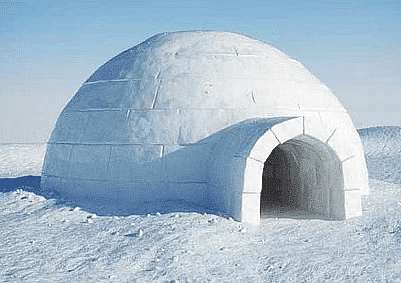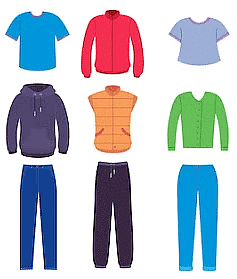Housing and Clothing Chapter Notes | Science Olympiad for Class 3 PDF Download
Houses

Houses are buildings where people live. They are like cozy shelters that protect us from the weather, like rain, wind, and snow. Houses have rooms where we can sleep, eat, relax, and spend time with our families.
Types of Houses
People reside in diverse types of dwellings, and mobility between locations is common.
- Residences range from temporary to permanent structures, encompassing both sturdy and makeshift accommodations.
- The homes we inhabit serve as shields against various elements such as heat, rain, wind, dust, and potential wildlife encounters.
- Construction of homes varies regionally, with designs tailored to suit the prevailing climate conditions of each area.
Houses in Different Regions
Houses in cold regions
Igloos
 In areas like the Arctic and Polar Regions, where snow covers the landscape and temperatures plummet, inhabitants construct igloos from blocks of snow, typically in a dome shape that provides warmth within. These snow houses, also known as igloos, are essential shelters in these frigid environments.
In areas like the Arctic and Polar Regions, where snow covers the landscape and temperatures plummet, inhabitants construct igloos from blocks of snow, typically in a dome shape that provides warmth within. These snow houses, also known as igloos, are essential shelters in these frigid environments.
The indigenous people of Arctic regions, including Greenland, Canada, and Alaska, are referred to as the Inuit, with "Inuk" being the singular form.
Wooden houses
 In contrast, in the cold and wooded regions of America, people opt for wooden houses or log cabins. Wood, abundant in these areas, serves as an excellent regulator of interior humidity and temperature. Its insulating properties help maintain comfortable conditions year-round, keeping the house cool in summer and warm in winter.
In contrast, in the cold and wooded regions of America, people opt for wooden houses or log cabins. Wood, abundant in these areas, serves as an excellent regulator of interior humidity and temperature. Its insulating properties help maintain comfortable conditions year-round, keeping the house cool in summer and warm in winter.
Hot and Dry Regions: Traditional Dwellings
Mud/Clay Houses
In hot and arid climates, such as those found in regions like Mexico, mud houses are a common sight. Mud, often mixed with materials like straw or sticks, is used in construction. These structures provide effective insulation against the heat.
Brick Houses

In ancient Egypt, situated in hot and dry regions, inhabitants crafted brick houses from baked mud bricks, known for their durability. These brick houses replaced traditional mud and straw structures. Bricks, made from clay, are molded, dried, or fired to create sturdy building materials. Today, brick houses are prevalent in urban areas, offering lasting and resilient accommodation.
Houses in Hot and Wet Regions
Huts

In the hot and humid climate of Africa, inhabitants traditionally built huts using locally abundant materials like grass, leaves, and vines. These structures, commonly found in villages, feature mud walls and straw roofs, offering natural cooling properties during the summer months.
Other Types of Houses
Stilt Houses
- Commonly found in regions prone to heavy rain and flooding, such as parts of Southeast Asia and West Africa, stilt houses are elevated on legs above the ground to protect against floodwaters.
Temporary Houses
- Temporary dwellings, often constructed for vacations or camping trips, are commonly built by fishermen along coastal areas using materials like wood or coconut leaves. Modern versions of temporary houses utilize more durable materials for improved comfort and longevity.
Tents
- Tents, frequently used for holiday camping, are made from waterproof materials like canvas cloth or nylon, providing shelter while allowing for mobility.
Tipi or Tepee
- Historically popular among Native American tribes, tipis are conical tents crafted from animal skins or birch bark, offering portable and weather-resistant accommodation.
Caravans
- House on wheels, known as caravans, can be pulled by animals, cars, or trucks, enabling mobility and flexibility in residence. Caravans are commonly used for traveling from one location to another.
Houseboats
- Floating residences situated on water bodies like lakes, houseboats vary in size and may feature multiple stories. Some are used for vacation purposes, while others serve as permanent residences. Houseboats are found in various locations, including Hong Kong and Holland.
Clothes
Early humans used leaves and animal skins for clothing. Nowadays, clothing serves multiple purposes beyond mere coverage, including protection from weather elements, insect bites, and expressing personal style.
Functions of Clothes:
- Winter: Clothes help in keeping warm during cold seasons.
- Summer: They protect from the sun's heat and allow airflow to keep cool.
- Weather Protection: Clothes safeguard against rain and insect bites.
- Aesthetics: Clothes also contribute to our appearance and personal style.
Types of Fibres
- Natural Fibres: Obtained from plants (e.g., cotton, jute) or animals (e.g., wool, silk).
- Synthetic Fibres: Man-made in factories (e.g., nylon, polyester).
Examples of Fibres and Clothing
- Winter Clothes: Woolen garments trap body heat, keeping us warm. In extremely cold regions, fur clothes are worn for extra insulation.
- Summer Clothes: Light-colored linen or cotton fabrics allow body heat to escape, keeping us cool.
- Rainy Weather: Waterproof materials like raincoats, umbrellas, and gumboots protect from rain.
Points to Remember about Housing and Clothing:
- A house provides shelter and protection from various elements.
- Different types of houses include kachcha (made of mud and straw) and pakka (made of bricks, iron, and cement).
- Special types of houses include igloos, caravans, and stilt houses.
- Good houses should have proper ventilation, drainage systems, and green spaces.
- Fibres are categorized into natural and synthetic types.
- Seasonal clothing includes woolens for winter and cotton/linen for summer.
|
32 videos|86 docs|53 tests
|
FAQs on Housing and Clothing Chapter Notes - Science Olympiad for Class 3
| 1. What are the different types of houses mentioned in the article? |  |
| 2. How can one maintain their house properly? |  |
| 3. What are some common types of clothing mentioned in the article? |  |
| 4. How can one take care of their clothes to make them last longer? |  |
| 5. What factors should be considered when choosing a house to live in? |  |

















